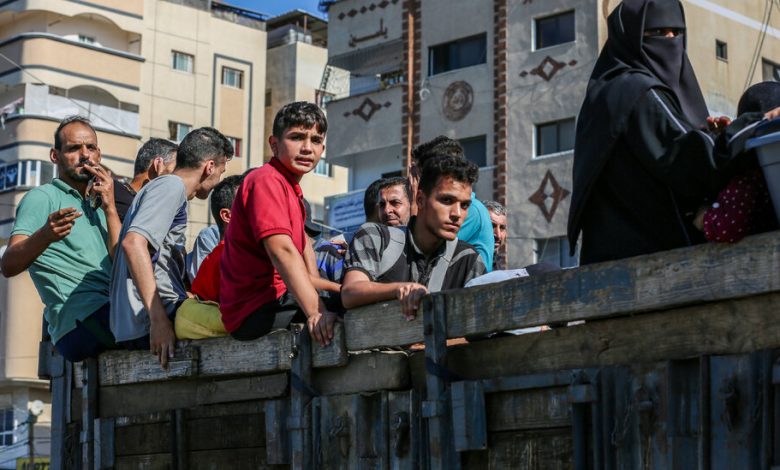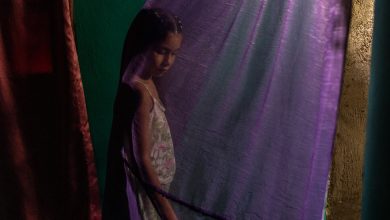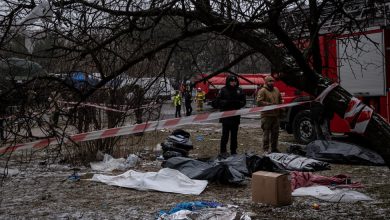Nearly Half of Gaza’s Population Displaced in Humanitarian Crisis

In southern Gaza’s main city, Khan Younis, throngs of people displaced from the north stood in the streets on Saturday outside schools, hospitals and the homes of friends who took them in, waiting with their empty bottles for the water truck to come by.
When it passed, they surged forward, each one desperate to fill up a bottle or two to quench the thirst of the families they fled with.
“The hardest thing today is finding water to drink,” said Jihad Abu Hasaan, 54, a father of three who left his home in Gaza City in the north on Friday. “We hope that there is a humanitarian pause so that people can at least go search for water,” he added. Mr. Hasaan, the Gazan director of Première Urgence Internationale, a Frenchcharity, spoke from a training center in Khan Younis where his family was sheltering with some 5,000 people.
A fast-growing humanitarian crisis has erupted in southern Gaza, which is being inundated by hundreds of thousands of displaced people who fled northern Gaza in the past day alone, according to the UNRWA, the U.N. agency that aids Palestinians. In total, nearly half of Gaza’s population of more than two million has been displaced over the past week, the agency said on Saturday.
The entire Gaza Strip is in danger of running out of water, the United Nations warned on Saturday. Many Gazans do not have access to clean drinking water and are resorting to drinking polluted water. For some, it is down to a struggle to stay alive and meet basic needs, including finding food or a place to shelter.
“It has become a matter of life and death,” said Philippe Lazzarini, the commissioner general for UNRWA. “It is a must: Fuel needs to be delivered now into Gaza to make water available for two million people.”
Khan Younis has been inundated over the past day with many of those streaming down from the north after the Israeli Army ordered more than one million residents of the area to leave their homes, anticipating an Israeli ground invasion in the coming days that now seems all but inevitable.
This round of violence was triggered one week ago when Hamas, the group that controls Gaza, staged a surprise attack on southern Israel that killed more than 1,300 people.
Israel responded over the past week with an air bombardment on the densely populated coastal enclave. On Monday, Israel’s defense minister imposed what he called a “complete siege” of Gaza, saying this would prevent electricity, food, water and fuel from entering the territory that has been blockaded by Israel and Egypt for the past 16 years.
Clean water is running out after Gaza’s water plant and public water networks stopped working because of a lack of fuel, the U.N. said, adding that people are resorting to drinking dirty water from wells, increasing the risks of waterborne diseases. Gaza’s three water desalination plants, which were producing 21 million liters of drinking water a day, have also halted operations because they are without fuel.
Israel provided water to Gaza before the Hamas attack a week ago, but cut off the supply on Oct. 9, the U.N. said.
The displaced people are grappling with the threats from airstrikes above, the lack of water and the absence of virtually any havens to take refuge from it all.
On Saturday, a doctor from the Al-Shifa hospital, the biggest medical center in Gaza where thousands of wounded people and people seeking shelter from the airstrikes are staying, was killed in an Israeli airstrike. He had gone home to take supplies to his family after a week of working straight through and not leaving the hospital, according to Gazan authorities. Several members of his family were also killed.
They were among more than 300 people reported killed on Saturday, including 90 children and 107 women, according to the Palestinian Authority’s Foreign Ministry in the West Bank.
At least 70 people caught up in the exodus from northern Gaza on Friday were killed when Israeli airstrikes hit a convoy of vehicles fleeing south, according to the Gazan authorities. Israel said it was looking into the matter.
At least 2,215 Palestinians have been killed in Gaza since last Saturday, the territory’s Health Ministry said, including 724 children and 458 women. More than 8,700 have been wounded.
By Saturday, displaced families were crammed into schools and hospitals in the south, while others crowded into the houses of friends and family. Many more were sleeping out in the open in the streets even as Israeli airstrikes, including on southern Gaza, continued.
When Mr. Abu Hasaan and his family arrived on Friday at the training center in Khan Younis, they found no mattresses or blankets. Even basics like soap in the bathrooms were missing, Mr. Abu Hasaan said. But water remained their primary concern.
“It’s very hard to have enough water for the people who are displaced,” he said.
“Sometimes, people ask for water from each other,” he added. “But those who still have water only have a little, so people are ashamed to ask. And if they are able to give, it’s only a small amount. But people are still helping each other.”
Aid groups were struggling to distribute any supplies as their own stocks, including fuel and food, dwindled amid the Israeli siege. The International Committee of the Red Cross said it was able to distribute some fuel to water tank trucks so they could make their rounds, as well as fuel for some water pumping.
“It’s a struggle for life here,” said a Gaza resident, Zeina Ghanem, speaking on Saturday morning from a training center run by UNRWA in southern Gaza. “There’s no food. There’s no water. There’s no sleep.”
There were 500 displaced people from northern Gaza — men, women and children — all packed into one small hall, she said.
Many Gazans chose not to heed the evacuation order, saying that the south was no safer than the north, and that they would rather die at home. They also feared that those who left their homes would not be allowed back, a repeat of the 1948 mass displacement of more than 700,000 Palestinians who were either expelled or fled their homes in present-day Israel and were never allowed to return.
Many in Gaza City in the north, the main population center in the territory, refused to leave and instead sought shelter in the city’s schools and hospitals.
The hospitals are also overwhelmed by both wounded people from the weeklong assault, as well as by families seeking safety in their corridors and courtyards.
Israel ordered Al Quds hospital in Gaza City, which is run by the Palestine Red Crescent Society, to be evacuated on Saturday, according to the organization.
The hospital’s administration said it would not evacuate patients, including some who were in the intensive care unit, as well as dozens of others, including children in incubators and those wounded by Israeli airstrikes.
It was not the only hospital in Gaza to get a direct order from Israel to evacuate.
The Red Crescent said on Friday that it did not have the means to evacuate the sick and wounded from hospitals, nor older or disabled people.
Samar Abu Elouf and Ameera Harouda contributed reporting from Gaza, and Iyad Abuheweila from Cairo.




